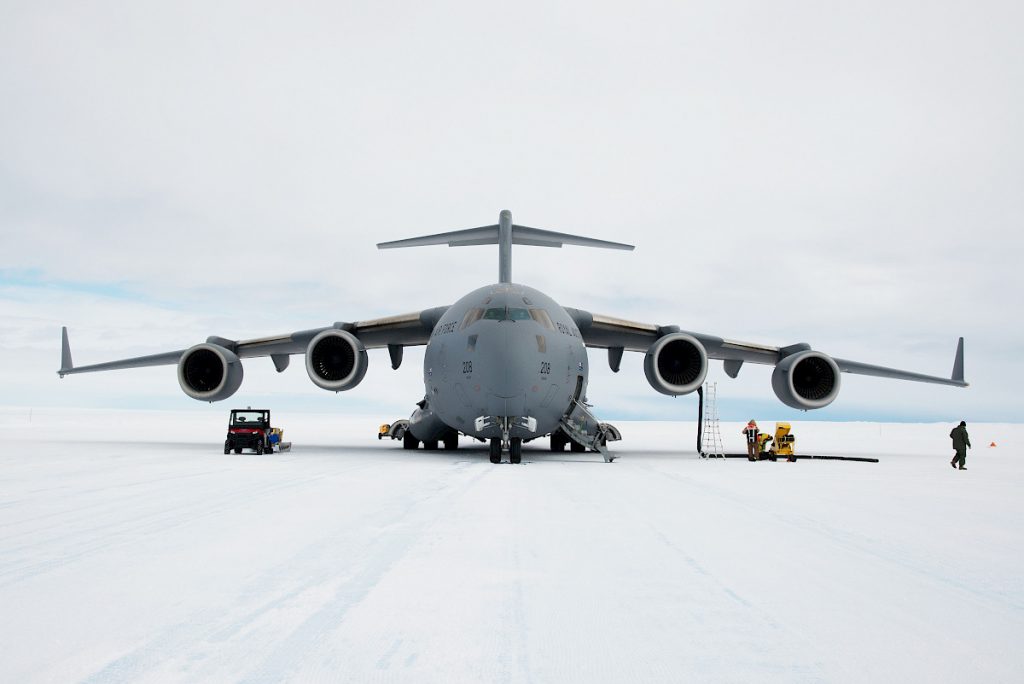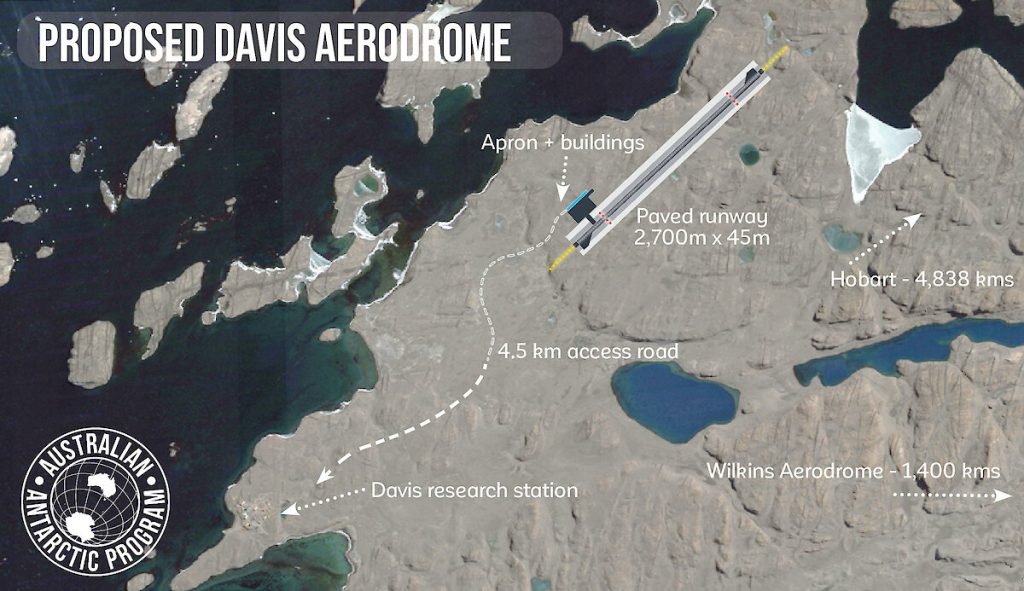
Next year, the Australian government will decide on whether to commit funding for a proposed year-round, paved aerodrome in the Vestfold Hills area, near the Australian Davis research station in East Antarctica. An all-weather, year-round, paved runway near Davis would have huge positive impacts on Antarctic science and logistics in East Antarctica, where there are no equivalent facilities. It would be the only paved runway in Antarctica.
The ice-free Vestfold Hills site is particularly attractive for an aerodrome development. The proposed site will allow for construction of a paved concrete runway on rock, at low elevation, close to the sea, in a place with a benign climate, and with a runway alignment naturally suited to the prevailing winds: all factors that make it uniquely suitable in Antarctica for all-season air access.
The proposal is for a 2.7-kilometre runway as well as aircraft hangars, a small terminal facility, storage buildings, fuel storage and other support services. The aerodrome and associated infrastructure would occupy 2 square kilometres, or less than 0.5% of the Vestfold Hills. The location of the proposed aerodrome is shown below.
 Source: Australian Antarctic Program.
Source: Australian Antarctic Program.
The idea for an aerodrome near Davis was part of the government’s
20-year action plan that set out to guide decisions on the future of Australia’s Antarctic program. In 2018, the Australian government announced that it intended to construct the runway, subject to necessary environmental and other approvals, but it didn’t commit to the funding at that time.
The Davis aerodrome will provide a step-change to the Australian Antarctic program through a significant upgrade in aviation capacity, which currently relies upon summer-only access to Australia’s Wilkins aerodrome near Casey Station.
In a
new ASPI report released today, we argue that the new runway will be a gamechanger in Australia’s access to East Antarctica. It will increase our ability to collaborate with all countries active in that region. It will act as both a destination for intercontinental science and logistics flights from Australia and a hub for distributing personnel and equipment, via intracontinental flights, to Australian and various other national research bases in East Antarctica. The expected aviation routes for the Davis aerodrome are shown below.
 Source: Australian Antarctic Program.
Source: Australian Antarctic Program.
As with any major piece of infrastructure development, the construction and operation of the Davis aerodrome will have some inevitable environmental impacts. However, we believe that, with care, it should be possible to design, construct and operate a facility that satisfies both operational requirements and environmental obligations under the Madrid Protocol and relevant Australian legislation.
While we acknowledge that there are some valid concerns about the aerodrome proposal, there are also strong national interest grounds to proceed.
First, the Davis aerodrome will further demonstrate our maturity, leadership and influence in Antarctic science and diplomacy. It will provide Australia with a central role in Antarctic logistical supply chains for several national research bases in East Antarctic, such as the nearby Chinese, Russian and Indian bases. Australia will become the logistics country of choice for East Antarctica and a primary driver of scientific and logistical cooperation in the area immediately to Australia’s south, in the vicinity of our existing Antarctic research programs.
Second, if Australia doesn’t proceed with the aerodrome, another country may step into our shoes and take a similar proposal forward. It might be a country with lower standards of environmental assessment and a lesser track record of environmental protection in Antarctica. In that situation, access to the facilities would be controlled by another country and constructed to the environmental and operational standards of that state. Australia would be put in the position of having to negotiate, and possibly pay for, access to a facility adjacent to its own station.
Third, if an aerodrome proposal proceeds for the Vestfold Hills area, it’s in our interest, and the interest of all other Antarctic Treaty countries, that such major infrastructure be designed, constructed and operated so as to minimise the environmental impacts. We already have specific and longstanding domestic legislation that provides detailed rules for environmental assessment of all significant Australian activities in Antarctica, including inviting public submissions and heeding expert advice. Having Australia as the proponent for an aerodrome therefore has significant advantages in the level and quality of environmental assessment that can be expected and in compliance with any operating conditions imposed.
We would also be able to prevent inappropriate uses by other potential operators, such as using the aerodrome to support permanent tourist facilities in the region. Tourist use of the aerodrome has been ruled out by Australia.
Finally, the Davis aerodrome will boost the position of Hobart as a centre for Antarctic logistics and science. It will make Hobart the pre-eminent gateway city to East Antarctica. That will build and solidify Australia’s diplomatic and scientific influence in the region.
Even though it won’t become operational for more than a decade, the Davis aerodrome project should be a high priority for Australia. We should send the strongest message that this country is determined to maintain a credible long-term leadership role in Antarctica in a responsible way.
It would be easy to again put off a hard decision about strengthening our capacity in the region south of Australia. But as international interest in Antarctica increases, this is no time for complacency. The development of an all-weather, year-round, paved runway at Davis will be a gamechanger for the Australian Antarctic program and increase our strategic weight in the frozen continent.
 Print This Post
Print This Post

